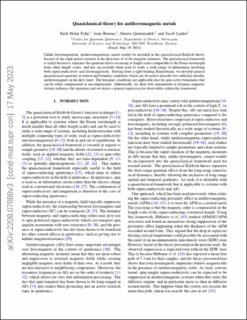| dc.contributor.author | Fyhn, Eirik Holm | |
| dc.contributor.author | Brataas, Arne | |
| dc.contributor.author | Qaiumzadeh, Alireza | |
| dc.contributor.author | Linder, Jacob Wüsthoff | |
| dc.date.accessioned | 2024-03-06T14:17:25Z | |
| dc.date.available | 2024-03-06T14:17:25Z | |
| dc.date.created | 2023-05-14T23:29:41Z | |
| dc.date.issued | 2023 | |
| dc.identifier.issn | 2469-9950 | |
| dc.identifier.uri | https://hdl.handle.net/11250/3121320 | |
| dc.description.abstract | Unlike ferromagnetism, antiferromagnetism cannot readily be included in the quasiclassical Keldysh theory because of the rapid spatial variation in the directions of of the magnetic moments. The quasiclassical framework is useful because it separates the quantum effects occurring at length scales comparable to the Fermi wavelength from other length scales, and has successfully been used to study a wide range of phenomena involving both superconductivity and ferromagnetism. Starting from a tight-binding Hamiltonian, we develop general quasiclassical equations of motion and boundary conditions, which can be used to describe two-sublattice metallic antiferromagnets in the dirty limit. The boundary conditions are applicable also for spin-active boundaries that can be either compensated or uncompensated. Additionally, we show how nonuniform or dynamic magnetic textures influence the equations and we derive a general expression for observables within this framework. | en_US |
| dc.description.abstract | Quasiclassical theory for antiferromagnetic metals | en_US |
| dc.language.iso | eng | en_US |
| dc.publisher | American Physical Society | en_US |
| dc.rights | Navngivelse 4.0 Internasjonal | * |
| dc.rights.uri | http://creativecommons.org/licenses/by/4.0/deed.no | * |
| dc.title | Quasiclassical theory for antiferromagnetic metals | en_US |
| dc.title.alternative | Quasiclassical theory for antiferromagnetic metals | en_US |
| dc.type | Peer reviewed | en_US |
| dc.type | Journal article | en_US |
| dc.description.version | acceptedVersion | en_US |
| dc.rights.holder | ©2023 American Physical Society | en_US |
| dc.source.volume | 107 | en_US |
| dc.source.journal | Physical review B (PRB) | en_US |
| dc.source.issue | 17 | en_US |
| dc.identifier.doi | 10.1103/PhysRevB.107.174503 | |
| dc.identifier.cristin | 2147380 | |
| dc.relation.project | Norges forskningsråd: 262633 | en_US |
| dc.relation.project | Norges forskningsråd: 323766 | en_US |
| cristin.ispublished | true | |
| cristin.fulltext | postprint | |
| cristin.qualitycode | 2 | |

